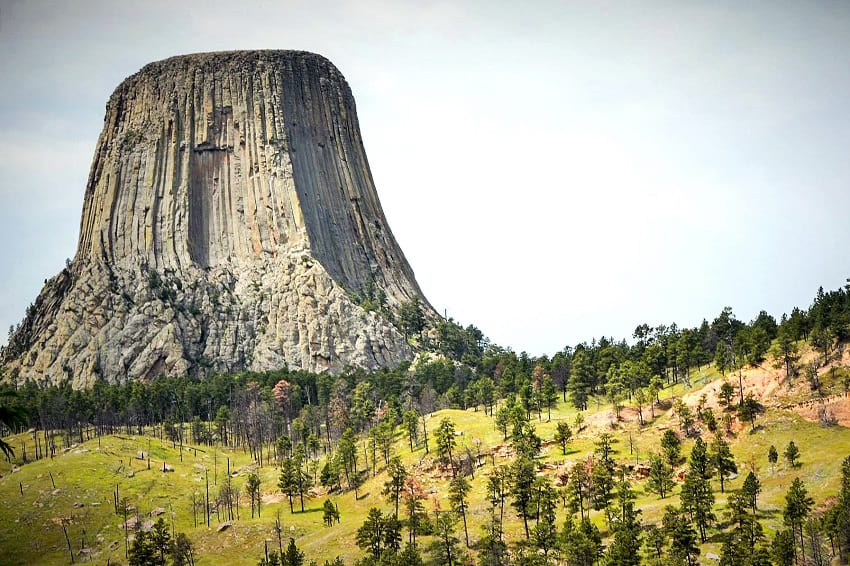Devils Tower in Wyoming: A National Monument and a Geological Wonder
Share

Devils Tower National Monument. (Christen Gobel / Wikimedia Commons)
A film script is a baseline on which location for the shoot is decided. Steven Spielberg did the same. But the location found was so enticing that he discarded the script. And location became a new baseline, for an altogether new story. The result was the blockbuster Hollywood release of 1977, Close Encounters of the Third Kind. The location was a foothill called Devils Tower. But there is more to this giant stub, than what meets the eye on the silver screen. It is a mix of the physical and the metaphysical in Wyoming, America, near river Belle Fourche.
Devils Tower in Wyoming: A national monument
The Devils Tower is 867 feet high. Its top surface measures an acre and a half, and base circumference – about a mile. Declared a National Monument of America in 1906, the tower was held sacrosanct by the Indian tribes of America’s Northern Plains. Several word-of-mouth histories and references testify to its spiritual significance. In Arapahoe, the tower is called ‘Bear’s tipi’. Kiowa, another county, calls it ‘aloft on a rock’ and ‘tree rock’. The Native American tribes have used several expressions like: Bear Lodge, Bear Lodge Butte, Grizzly ear’s Lodge, Mythic-owl mountain, Grey Horn Butte, and Ghost Mountain. As wild bears inhabited the area in the past, the animals’ name became part of the tower’s identity.
The naming exercise was riddled with misinformation
How come Tower got named differently than mentioned in history and legends? The story begins with a geologist, Colonel Richard Irving Dodge, going on a scientific expedition to the Black Hills Region of Wyoming in 1875. He inquired about the tower’s name in the local language and understood the answer as ‘Wakansica’. That, translated into the English language, read ‘The Bad God’s Tower’. It was simplified to ‘Devil’s Tower’.
Now, the question arises about the missing apostrophe in ‘Devil’s Tower’. And why an ungrammatical usage ‘Devils Tower’ remains current? President Theodore Roosevelt had approved the same name as coined by Colonel Dodge, i.e. with-apostrophe Devil’s Tower. But a clerical mistake in the office of the president bypassed apostrophe and posted name as Devils Tower. The mistake was never corrected, so it remained as such. In the meanwhile, another mistake came to light. Colonel Dodge had inadvertently picked up a wrong word for translation. Right word was a similar sounding, but different, Wahanksica, which translates to English as ‘black bear’. This is also corroborated from multiple sources as explained in the foregoing.
Locals, who hold tower sacrosanct, demanded the renaming of ‘Devils Tower’ as ‘Bear Lodge’. Demand was rejected on the ground that a change would confuse people, and harm tourism.
Devils Tower formation
How the tower was formed is equally fascinating. From the earth’s hot inner core, molten rock (magma) keeps moving upwards. It may, or may not, reach to the surface of the earth. One such move happened 50 million years ago, but remained short reaching surface, thanks to a sedimentary rock coming in its way. In course of time, the sedimentary rock withered away, revealing the track followed by the intrusive lava. The magma or lava had cooled down into pillars of hexagonal shape, giving the protruding igneous rock an awesome formation. Grossly, the pillars appear to be hollow, but in reality, these are solid. The rock, light grey to beige coloured, is totally devoid of quartz (a plentiful mineral of the earth – crust).

Devils Tower. (Wikimedia Commons)
A crucible of nature’s bounties, adventure, outing and human faith
Vegetation on Devils Tower is a mix of lichens, moss and grasses. Chipmunks (squirrels) and more than 160 species of birds inhabit the top part of it. The Pine forest and the grasslands in surrounding areas are home to 40 species of mammals. That apart, the region has a vibrant population of amphibians, fishes and reptiles.
The tower is a popular destination for rock climbing. Prominent columns on the shaft are ideal for clutching, tethering and climbing the rock, and have a rocking experience. Five to six thousand rock climbers come here every year, especially in the month of June. That, incidentally, is also the time when people visit the tower for religious rites. In spite of being a tourist hub, Devils Tower retains its past image of a spiritual domain. Rituals of faith are a routine on the tower’s sacred sites, and tourists are advised not to touch objects related to such rituals.
Enjoyed this article? Also, check out “Devils Hole: The Only Wild Habitat in the World Where the Endangered Devils Hole Pupfish Are Found“.
Fact Analysis:
STSTW Media strives to deliver accurate information through careful research. However, things can go wrong. If you find the above article inaccurate or biased, please let us know at [email protected]













